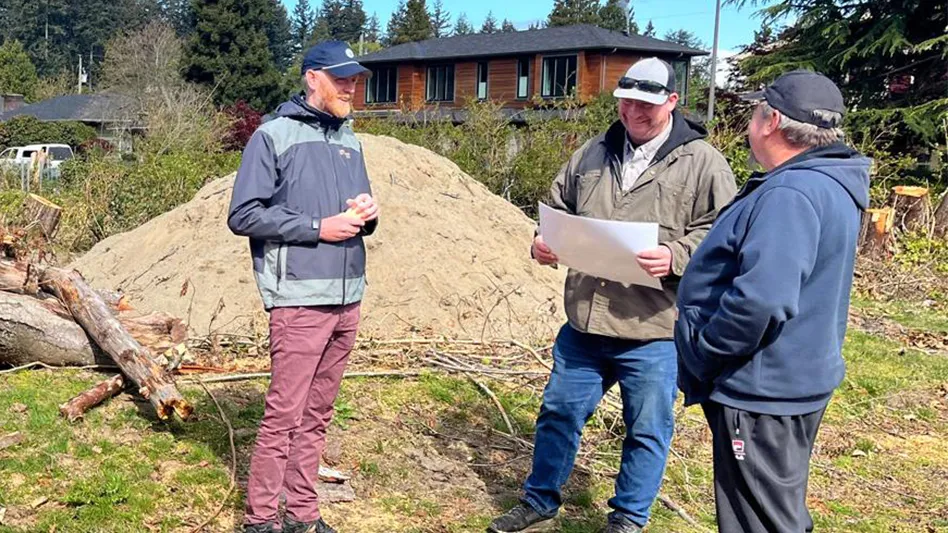
Adobe Stock
At the 2024 GCSAA Conference and Trade Show in Phoenix at the end of January, I took an excellent seminar called “Managing Biotic and Abiotic Stresses of Annual Bluegrass Putting Greens.” It was a great class for those of us who actually manage Poa instead of trying to eradicate it. Let’s just say the Pacific Northwest was well represented in the room.
Three Oregon State University researchers led the class: associate professor Dr. Alec Kowalewski, assistant professor Dr. Chas Schmid and graduate research associate Emily Braithwaite.
The seminar covered a variety of topics concerning Poa management: Plant Growth Regulators (including a lot of info on PGRs relation to Growing Degree Days), cultivation and recovery from cultivation, billbug control (a rising problem), topdressing timing, patch diseases and fungicide selection, anthracnose control (a definite issue in this region) and, within the section on diseases, fungicide alternatives.
The topic of fungicide alternatives piqued my interest from the course description and led me to choose this particular class over many other choices. Fungicide alternatives are something all of us must understand as increasingly more fungicide restrictions and outright bans are certainly coming our way in the future.
To illustrate the importance of this, sitting next to me in the seminar was a superintendent from Portugal. When Kowalewski asked the class if anyone was already feeling a major impact as a result of fungicide restrictions, the Portuguese superintendent raised his hand and proceeded to inform us that he was limited to just three fungicides available for use on his golf course. And he believed within five years that number was likely to be zero.
Zero gets your attention.
If that Portuguese superintendent is truly reading the tea leaves correctly and a complete ban of fungicide use is inevitable in his home country, he will need alternatives, which explains his presence in this particular room. As scary as this may sound, the rest of us might not be too far behind him.
Many of us are watching closely how the future of two of the more commonly used fungicides on golf courses are going to be regulated, restricted or possibly even banned for use. Chlorothalonil and PCNB have a bit of a cloudy future as far as remaining registered for golf course usage.
I must admit I apply more chlorothalonil to the greens on our golf course than any other chemical formulation. What would it look like if I could no longer make those preventive applications of chlorothalonil on our Poa annua greens?
For starters, I wouldn’t panic. But I would definitely begin exploring some options, alternatives, changes in how you think about disease and how you will possibly manage it differently. There are going to be steps to chemical restrictions before the ultimate removal of registered-use products altogether. It’s unlikely we will see complete bans immediately, like they are experiencing in Portugal and other countries. Which is not to say they aren’t coming, but more than likely there will be phases as more chemicals enter the conversation for restriction and bans. Restrictions, in this case, will mean limited use. These restrictions will most likely come before complete bans.
This means there will be steps to managing disease for all of us in the coming years. The process involves finding alternatives within chemical use (applying formulations that are safer and will still be allowable for us) and alternatives without any chemical use.
This is where we need help. Superintendents are not equipped to fight this battle alone. We are reliant on research.
Thankfully, it’s out there. It’s happening across the country, not just in Corvalis, Oregon. There are many smart people who have performed research for years in their little “corners of the world.” They are doing the hard leg work for us and providing us with those positively essential alternatives that we are going to need.
The trio from Oregon State has been executing this type of needed research. And they are starting to provide us with some possible alternatives for disease control in our region, specifically for anthracnose and Microdochium patch, our most common problems here on the West Coast. Iron sulphate, phosphorus acid and chelated iron, sulfur and lime, N-P-K ratio, crop oil, rolling, bio-control agents, and nitrogen source are among the items they are exploring in their fungicide alternatives and Microdochium patch research. With regards to the last item, they are researching how different nitrogen sources (urea, calcium nitrate, potassium nitrate, ammonium sulphate or a combo of urea and magnesium sulphate) can combat disease.
There’s something particularly interesting to me in the nitrogen source we choose for fertility being an actual combatant of a disease we have long battled in this region. Utilizing and tweaking things we are already using to basically repurpose them offers encouragement in this coming shift in disease control.
Of course, more research is needed. Not just for Microdochium patch control in the Pacific Northwest, but for every disease we encounter currently being controlled with fungicides.
As I sat next to the peer from Portugal for those four hours in the Phoenix Convention Center classroom, I keenly felt sympathy for his plight. But I also realized it’s not just his plight. It’s soon to mine as well.
Ron Furlong is the superintendent at Avalon Golf Club in Burlington, Washington, and a frequent Golf Course Industry contributor.





